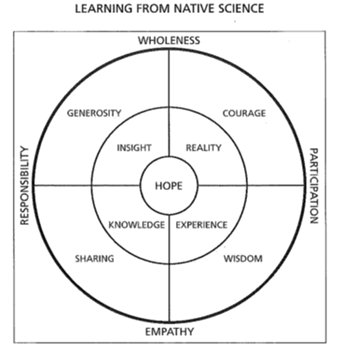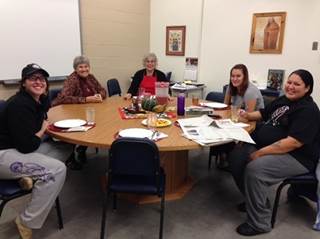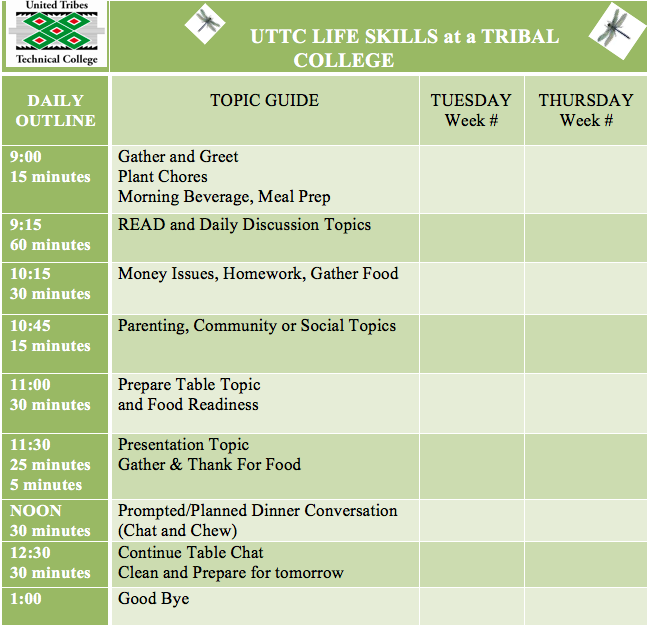 |
October 2017
|
October 2017 // Volume 55 // Number 5 // Ideas at Work // v55-5iw5
Life Skills at a Tribal College: A Culturally Relevant Educational Intervention
Abstract
American Indians, Alaska Natives, and Native Hawaiians (AI/AN/NH) experience the lowest rates of college retention and significant barriers to graduation. In addition, AI/AN/NH individuals face health challenges that include higher rates of obesity, overweight, and type 2 diabetes. We designed a culturally relevant life skills curriculum based on family and consumer science standards to promote educational achievement, self-efficacy, and healthful food choices among tribal college students. The Life Skills at a Tribal College course was delivered by tribal college Extension professionals in a family meal–style environment and involved culturally appropriate, traditional ways of learning to promote positive educational and health outcomes.
Program Need
American Indian, Alaska Native, and Native Hawaiian (AI/AN/NH) students enrolled in colleges across the United States bring cultural experiences, values, and strengths to the learning environment; moreover, graduates provide needed diversity in a variety of employment capacities. Unfortunately, AI/AN/NH students have significantly lower college enrollment, retention, and graduation rates than other ethnic groups (Freeman & Fox, 2005; Hunt & Harrington, 2010; National Center for Education Statistics, 2007, 2016; U.S. Department of Education, 2008).
Educational challenges for AI/AN/NH students include underpreparation, difficulties adjusting to the academic community, problems with family and self, cultural differences, social isolation, and financial complications (Hoover & Jacobs, 1992; Hunt & Harrington, 2010; Vermillion, 2012; Wells, 1989). Additional barriers to education include poverty, bias/discrimination, health disparities, lack of access to health care, lack of availability of culturally competent health services, and underfunding of health programs (U.S. Commission on Civil Rights, 2004; Warne, 2006, 2015). Because income and education level are predictors of health status, low per capita income and educational levels of AI/AN/NH individuals are of particular concern (Deaton, 2002; Warne, 2006, 2015).
Additionally, educational barriers and poverty are obstacles to making healthful food choices. Unfortunately, AI/AN/NH individuals experience disproportionate levels of chronic health conditions that are influenced by food choices, such as type 2 diabetes and overweight/obesity (Centers for Disease Control and Prevention, 2009, 2014, 2015; Zephier, Himes, & Story, 1999; Zephier, Himes, Story, & Zhou, 2006). Meal planning and preparation are essential life skills that can positively influence food choices (Fordyce-Voorham, 2011; Krieger, 2013; Larson, Perry, Story, & Neumark-Sztainer, 2006). In addition, self-esteem and decision making have been identified as life skills important for developing self-efficacy, and improved self-efficacy can increase the likelihood of choosing healthful foods (Adams et al., 2012; Bandura, 1997; Duerden & Witt, 2011).
Introduction and Objectives
Enrollment of AI/AN/NH students at the 37 1994 tribal land-grant colleges and universities (TCUs) continues to rise (U.S. Department of Education, 2016). TCUs provide Extension services, including services that focus on nutrition and health in tribal communities (U.S. Department of Agriculture [USDA] National Institute of Food and Agriculture [NIFA], 2016). Partnerships between 1994 and 1862 land-grant institutions and between educators and community partners demonstrate the collaborative nature of Extension and can provide effective educational and program strategies to meet the interests of tribal communities (Martenson, Newman, & Zak, 2011; USDA NIFA, 2016).
Programs intended to address college retention, self-efficacy, and healthful food choices among AI/AN/NH students should involve elements that promote academic success, including supportive instructors/staff, commitment/support from the educational institution, assistance with identifying personal goals, guidance about study skills, and encouragement to remain connected with home and cultural practices. Strategies that assist students in gaining self-efficacy relative to making healthful food choices include incorporating traditional methods of learning and cultural practices familiar to AI/AN/NH students, providing hands-on experiential learning opportunities to assist students in acquiring nutrition knowledge, and discussing barriers to making healthful food choices (and strategies for overcoming them).
In an effort to incorporate recommendations and strategies, as well as to address gaps identified in the literature, we formed a partnership between a 1994 land-grant institution (United Tribes Technical College [UTTC]) and an 1862 land-grant institution (North Dakota State University) to develop a life skills course. The three goals of the course were to improve college retention, build self-efficacy, and promote healthful food choices.
Program Description
The Life Skills at a Tribal College (LSTC) course was a semester-long curriculum. Life skills–specific topics centered on learning objectives included nutrition, budgeting, meal planning and preparation, food gathering (grocery and garden), family health, sovereign (sustainable/local) food systems, employment goals, money management, and communication. The curriculum was based on the North Dakota Family and Consumer Science Content Standards (2008), adapted for cultural relevance.
Adaptations for cultural relevance included the use of Cajete's (1994) learning from native science model (Figure 1) and a humanistic approach to learning. A humanistic approach values interdependence among students and between students and teachers, allows students to inform the direction of education, and promotes participation and relationship building in the learning environment (Cajete, 1999). In addition, a "grandmother-figure" as the primary instructor for the course reflected a matriarchal social order and the common indigenous value of learning from respected elders (Cajete, 1994; Calsoyas, 2006; Varcoe, Bottorff, Carey, Sullivan, & Williams, 2010). A grandmother-figure may not be suitable for paternalistic tribes; program planners should build understanding of tribal values to promote a culturally relevant learning environment.
Figure 1.
Native Science Model

From Look to the Mountain: An Ecology of Indigenous Education,
by G. Cajete, 1994, Kivaki Press, Durango, CO.
The adaption of the learning from native science model to the curriculum and an environment with relaxed communication among AI/AN/NH learners (Gilliland, 1995) were strategic to the class. Strategies that incorporate traditional styles of learning, such as experiential learning, storytelling, tutoring, rituals and ceremonies, observation, and open conversation between teacher and learner, were included (Bowman, 1994; Cajete, 1994; Castagna & Brayboy, 2008; Gay, 2000; Hooker, 2011; Ingalls, Hammond, Dupoux, & Baeza, 2006; Swisher, 1991). Class time was devoted to incorporating these strategies through regular class rituals, writing assignments, discussion time, hands-on experience, small-group interaction, and storytelling opportunities.
The LSTC course was delivered in a home-like setting on the UTTC campus that included cooking facilities and a large, round dining table (Figure 2). Each term, enrolled students met for a 4-hr class two times a week, for the full semester. Each class meeting included meal preparation and dining as a group. Course layout information (Figure 3) was provided to students at the beginning of the course. Lessons and daily activities (Figure 4) were planned with student input when possible.
Figure 2.
Round Dining Table Used During Life Skills at a Tribal College Course

Figure 3.
Life Skills at a Tribal College Course Layout Information Shared with Students
Daily schedule includes:
|
Classroom Expectations:
|
Daily Schedule: This is a flexible schedule but it provides a guide for our daily plans.
|
Figure 4.
Daily Outline and Weekly Lesson Planning Template for Life Skills at a Tribal College Course

Note. UTTC = United Tribes Technical College.
Evaluation and Outreach
Evaluation of the program included pre- and postprogram questionnaires as well as pre- and postprogram telephone interviews with each enrollee. Semester-to-semester retention of LSTC completers was 100%. General self-efficacy did not increase significantly, nutrition knowledge increased but not significantly, and nutrition attitudes and beliefs were not different between preintervention and postintervention. Dietary analysis reflected improved intake and eating behaviors; however, none of the participants met dietary recommendations for any food group.
Curriculum adapted and developed for the LSTC course was intended for widespread use and additional cultural adaptations as necessary. Curriculum materials, including recipes and learning objectives, are available for review, download, and educational use at http://www.uttc.edu/landgrant/resources/lifeskills/educators.
Summary
American Indians and Alaska Natives experience negative health issues that may be directly influenced by dietary intake and food patterns at disparate rates. In addition, AI/AN/NH students experience the lowest rates of college retention and graduation in the United States (National Center for Educational Statistics, 2007, 2016). Using a culturally relevant curriculum, such as LSTC, may improve college retention, nutrition knowledge, and eating behaviors among AI/AN/NH tribal college students.
Acknowledgments
Additional members and significant contributors to the project include grandmother-figure Marge Palaniuk, UTTC Nutrition and Foodservice Department chair Annette Broyles, and UTTC Extension educators Jan Keller, Jana Millner, Robert Fox, Colette Wolf, and Mara Yborra.
References
Adams, A., LaRowe, T., Cronin, K., Prince, R., Wubben, D., Parker, T., & Jobe, J. (2012). The Healthy Children, Strong Families intervention: Design and community participation. Journal of Primary Prevention, 33, 175–185.
Bandura, A. (1997). Self-efficacy: The exercise of control. New York, NY: Freeman.
Bowman, B. (1994). Cultural diversity and academic achievement. Retrieved from http://eric.ed.gov/?id=ED382757
Cajete, G. (1994). Look to the mountain: An ecology of indigenous education. Durango, CO: Kivaki Press.
Cajete, G. (1999). Native science: Natural laws of interdependence. Santa Fe, NM: Clear Light Books.
Calsoyas, K. (2006). Considerations in the educational process relative to Native Americans. Cambridge Journal of Education, 35, 301–310.
Castagna, A., & Brayboy, B. (2008). Culturally responsive schooling for indigenous youth: A review of the literature. Review of Educational Research, 78, 941–993.
Centers for Disease Control and Prevention. (2009). Minority health surveillance—REACH U.S. Retrieved from http://www.cdc.gov/features/dsreachus/
Centers for Disease Control and Prevention. (2014). National diabetes statistics report. Retrieved from http://www.cdc.gov/diabetes/pubs/statsreport14/national-diabetes-report-web.pdf
Centers for Disease Control and Prevention. (2015). National Center for Chronic Disease Prevention and Health Promotion. Division of Population Health. Behavior Risk Factor Surveillance System [BRFSS] Prevalence and trends data. Retrieved from http://www.cdc.gov/brfss/brfssprevalence/
Deaton, A. (2002). Policy implications of the gradient of health and wealth. Health Affairs, 21, 13–30.
Duerden, M., & Witt, P. (2011). Assessing the need for the development of standardized life skills measurements. Journal of Extension, 49(5), Article 5RIB5. Available at: https://www.joe.org/joe/2011october/rb5.php
Fordyce-Voorham, S. (2011). Identification of essential food skills for skill-based healthful eating programs in secondary schools. Journal of Nutrition Education and Behavior, 43, 116–122.
Freeman, C., & Fox, M. (2005). Status and trends in education of American Indians and Alaska Natives (NCES 2005-108). Retrieved from http://nces.ed.gov/pubs2005/2005108.pdf
Gay, G. (2000). Culturally responsive teaching: Theory, research, and practice. New York, NY: Teachers College Press.
Gilliland, H. (1995). Teaching the Native American (3rd ed.). Dubuque, IA: Kendall Hunt.
Hooker, D. (2011). Small, peer-led collaborative learning groups in developmental math classes at a tribal community college. Multicultural Perspectives, 13, 220–226.
Hoover, J., & Jacobs, C. (1992). A survey of American Indian college students: Perceptions toward their study skills/college life. Journal of American Indian Education, 32, 21–29.
Hunt, B., & Harrington, C. (2010). The impending educational crisis for American Indians: Higher education at the crossroads. Indigenous Policy Journal, 21, 1–13.
Ingalls, L., Hammond, H., Dupoux, E., & Baeza, R. (Winter, 2006). Teachers' cultural knowledge and understanding of American Indian students and their families: Impact of culture on a child's learning. Rural Special Education Quarterly, 25(1), 16–24.
Krieger, E. (2013). Bringing cooking back: Food and culinary expertise as a key to dietitians' future success. Presentation at the Food & Nutrition Convention & Expo, Houston, TX.
Larson, N., Perry, C., Story, M., & Neumark-Sztainer, D. (2006). Food preparation by young adults is associated with better diet quality. Journal of the American Dietetic Association, 106, 2001–2007.
Martenson, D., Newman, D., & Zak, D. (2011). Building community-university partnerships by listening, learning, and responding. Journal of Extension, 49(5), Article 5FEA4. Available at: https://www.joe.org/joe/2011october/a4.php
National Center for Educational Statistics. (2007). Graduation rates. Retrieved from http://nces.ed.gov/programs/digest/d11/tables/dt11_345.asp
National Center for Educational Statistics. (2016). The condition of education 2016. Retrieved from https://nces.ed.gov/pubs2016/2016144.pdf
Swisher, K. (1991). American Indian/Alaskan Native learning styles: Research and practice. (Report No. ED335175). Charleston, WV: Rural Education and Small Schools.
U.S. Commission on Civil Rights. (2004). Broken promises: Evaluating the Native American health care system. Retrieved from http://www.usccr.gov/pubs/nahealth/nabroken.pdf
U.S. Department of Agriculture National Institute of Food and Agriculture. (2016). NIFA tribal programs. Retrieved from http://nifa.usda.gov/program/nifa-tribal-programs
U.S. Department of Education. (2008). National Center for Education Statistics, Status and Trends in the education of American Indians and Alaska Natives. Alexandria, VA: ED Pubs.
U.S. Department of Education. (2016). White House initiative on American Indian and Alaskan Native education: Tribal colleges and universities. Retrieved from https://sites.ed.gov/whiaiane/tribes-tcus/tribal-colleges-and-universities/
Varcoe, C., Bottorff, J., Carey, J., Sullivan, D., & Williams, W. (2010). Wisdom and influence of elders: Possibilities of health promotion and decreasing tobacco exposure in First Nations communities. Canadian Journal of Public Health, 101, 154–158.
Vermillion, L. (2012, November). Native American students and higher education. Presentation at the pedagogical luncheon for North Dakota State University faculty, Fargo, ND.
Warne, D. (2006). Research and educational approaches to reducing health disparities among American Indians and Alaska Natives. Journal of Transcultural Nursing, 17, 266–271.
Warne, D. (2015, May). Impact of historical trauma on American Indian health disparities. Presentation at the Working in Native Directions (WIND) spring meeting for North Dakota State University students, staff, and faculty, Fargo, ND.
Wells, R. N. (1989). A survey of American Indian students. Retrieved from http://search.proquest.com/docview/63026150?accountid=6766
Zephier, E., Himes, J., & Story, M. (1999). Prevalence of overweight and obesity in American Indian school children and adolescents in the Aberdeen area: A population study. International Journal of Obesity, 23 (Suppl 2), S28–30.
Zephier, E., Himes, J., Story, M., & Zhou, X. (2006). Increasing prevalence of overweight and obesity in Northern Plains American Indian children. Archives of Pediatric & Adolescent Medicine, 160, 34–39.




